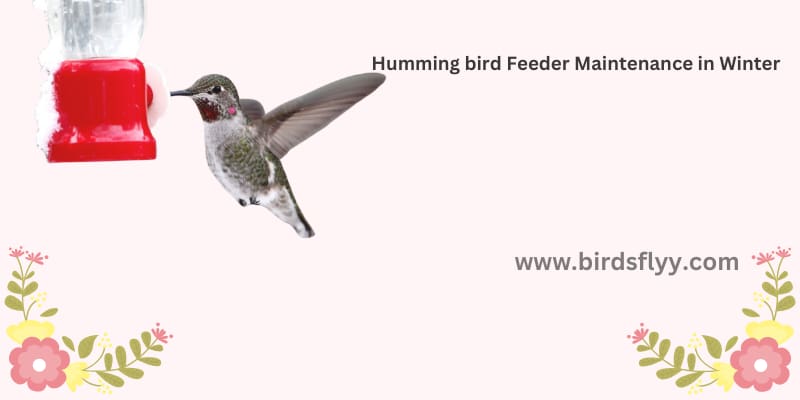Effective Strategies to Keep Hummingbird Feeders from Freezing
Maintaining a hummingbird feeder during the colder months presents unique challenges, primarily keeping the feeder from freezing. Here are some practical methods to ensure that your feeder remains accessible.Insulating the Feeder
Wrapping the feeder in insulation is a straightforward way to protect it from the cold. Materials such as foam insulation or even bubble wrap can be used to cover the feeder, helping to retain the heat and keep the nectar from freezing.
Using a Heat Source
Attaching a heat source, like a specially designed heat tape or a low-wattage incandescent bulb near the feeder, can provide enough warmth to prevent the nectar from solidifying.
Ensure that any heating element used is safe and specifically suitable for use with feeders to avoid damaging the feeder or harming the birds.
In Winter Feeder Maintenance
Placing the feeder in a location that receives direct sunlight during the day can naturally help keep the nectar from freezing.
Also read: In Winter Feeder Maintenance Additionally, hanging the feeder under a roof overhang or in a tree that provides some shelter from the wind can further reduce the risk of freezing.

Switching Nectar Solutions
Adjusting the sugar-to-water ratio in the nectar can also be effective. A mixture slightly richer than the standard 4:1 ratio, such as 3:1, will have a lower freezing point. However, it’s important not to make the mixture too sugary, which could be harmful to the birds.
Frequent Refills with Warm Nectar
Regularly replacing the nectar with a warm solution from inside your home can prevent freezing and ensure the freshness of the nectar. This is especially useful on particularly cold days.
Utilizing Commercially Available Feeder Heaters
Consider investing in a commercial hummingbird feeder heater or a heated feeder. These products are specifically designed to prevent nectar from freezing and are an easy solution for those who may not have the time to apply DIY methods.
Keeping Hummingbird Feeders Ice-Free
By implementing these strategies, you can ensure that your hummingbird feeder remains a reliable source of sustenance for hummingbirds throughout the winter.
Keeping the feeder ice-free not only helps the local hummingbird population thrive during the colder months but also allows you to enjoy bird watching all year round.
Read more:In Winter Feeder MaintenanceGuidelines for Maintaining Hummingbird Feeders in Winter
Introduction to Hummingbird Feeder Care in Cold Weather
As temperatures fall during the winter months, maintaining a liquid nectar supply in hummingbird feeders becomes a challenge due to the risk of freezing.
This guide provides several strategies to ensure hummingbirds have access to the nourishment they need despite the cold.
Using Heat Sources to Prevent Freezing
One effective method to prevent nectar from freezing is the use of light bulbs. Placing garden or outdoor lights around the feeder can provide sufficient warmth to keep the nectar fluid without overheating the feeder.
Ensure that the bulbs are positioned safely to avoid any risk of melting the feeder materials.
Insulation Techniques
Wrapping the feeder in insulating materials such as cloth overnight can help protect it from cold temperatures. Be sure to remove the insulation in the morning to allow the sun to warm the feeder, aiding in keeping the nectar thawed throughout the day.
Frequent Nectar Replacement
To minimize the risk of the nectar freezing, consider filling the feeder with smaller amounts and refilling it multiple times throughout the day.
This practice not only prevents the nectar from congealing but also ensures that it remains fresh and accessible to the birds.
Nighttime Storage
Another practical approach is to bring the feeder indoors during the night or whenever temperatures drop significantly. This prevents the nectar from freezing and can be placed back outside as the temperature warms up in the morning.
Specialized Feeders for Cold Weather:
Investing in feeders specifically designed for use in colder climates can be beneficial. These feeders come equipped with built-in insulation systems that help maintain the nectar at a suitable temperature, preventing it from freezing even during lower temperatures.
Using Glycerin as an Antifreeze
Adding a small amount of glycerin to the nectar can help prevent it from freezing. However, it’s crucial to use glycerin sparingly as it can be harmful to hummingbirds in larger quantities.
Regular Maintenance
Regularly check the feeder to ensure the nectar hasn’t frozen. If the nectar does freeze, replace it as soon as possible to continue providing a reliable food source for the hummingbirds.
Ensuring Continuous Nectar Supply in Winter
By implementing these strategies, you can effectively maintain your hummingbird feeder during the winter, providing a steady and safe food source for hummingbirds.
Regular maintenance and adaptation to the colder weather will make your backyard a favorable stop for these vibrant birds, even in the chilliest months.
Also read: Ensuring Continuous Nectar Supply in WinterSupporting Hummingbirds Through Winter: Understanding Their Survival Needs
Adapting to Mild Winter Conditions:While it’s natural to worry about hummingbirds during the colder months, it’s important to remember that they are well-adapted to handle mild winters.

Brief cold snaps pose little threat to these resilient birds, thanks to their ability to lower their body temperature at night, a process that conserves vital energy.
Sheltering Strategies of Hummingbirds:
Hummingbirds do not use nests or birdhouses for shelter during winter. Instead, they find refuge in trees and shrubs, which provide protection from the elements and potential predators.
This natural sheltering technique allows them to maintain their body heat and survive the chilly nights.
Nutritional Needs During Cold Weather:
During daylight hours, hummingbirds require a significant amount of sucrose, found in nectar, to sustain their energy levels. This high-calorie diet is crucial, especially in cold weather, to support their rapid metabolism.
In addition to nectar, hummingbirds consume insects, which are vital for their protein, vitamins, and minerals. Even in winter, these birds are skilled at finding insects on bark and under trees.
Challenges Posed by Extended Cold Periods:
Extended periods of cold can be challenging for hummingbirds, particularly in typically warm climates where they might not be as prepared for prolonged cold.
Read more:Challenges Posed by Extended Cold PeriodsWhile some birds may not survive these harsher conditions, many are able to endure by utilizing their remarkable adaptability and resourcefulness.One simple yet effective way to assist hummingbirds during winter is by continuing to provide a steady supply of nectar.
By maintaining clean and full feeders, we offer these tiny birds a reliable source of energy that can be critical to their survival during the colder months.
Aiding Hummingbird Resilience
Understanding the natural resilience and adaptive strategies of hummingbirds is key to supporting them through the winter. By providing shelter, consistent food sources, and recognizing their inherent toughness, we can help ensure that these enchanting birds thrive even during the coldest parts of the year.
Conclusion:
To effectively combat the coagulation of hummingbird nectar during colder weather, it’s essential to understand and implement strategies that ensure the nectar remains fluid and accessible. Employing methods like feeder insulation, using heated feeders, and regularly refreshing the nectar can prevent freezing and thickening, which can otherwise hinder a hummingbird’s ability to feed.
By taking proactive steps to maintain the quality and accessibility of nectar, we can support the health and energy needs of hummingbirds, ensuring they continue to thrive and enchant us with their presence, even in challenging climates.
FAQ’s: Feeder
1. What causes hummingbird nectar feed coagulation?
Coagulation in hummingbird nectar typically occurs due to low temperatures, which can cause the sugar solution to thicken or freeze.
2. How can coagulation of hummingbird nectar be prevented?
Preventing coagulation involves using feeder heaters, wrapping feeders in insulation, or increasing the sugar-to-water ratio slightly to lower the freezing point of the nectar.
3. Does coagulation affect the nutritional value of hummingbird nectar?
Coagulation itself does not change the nutritional value, but it can prevent hummingbirds from accessing the nectar, which they rely on for energy.
4. What are the signs of nectar coagulation in a feeder?
Signs include nectar that appears thicker than usual or has partially solidified, making it difficult for hummingbirds to consume.
5. What should be done if hummingbird nectar in a feeder coagulates?
If the nectar coagulates, it should be replaced with a fresh mixture. In colder weather, frequent checks and replacements may be necessary.
6. Can artificial additives prevent the coagulation of hummingbird nectar?
While some additives like glycerin can lower the freezing point of nectar, they should be used cautiously as certain additives can be harmful to hummingbirds.

